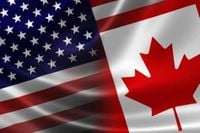The Canadian Dollar faces a challenging landscape as uncertainty looms ahead of anticipated tariffs from President Trump. The relationship between the CAD and its counterpart, the USD, has become increasingly pivotal for traders as they evaluate implications in currency exchange rates driven by emerging economic data and policy announcements.
Current analyses highlight the trends in related currency pairs, particularly USD/CAD, CAD/JPY, and EUR/CAD, as market participants are keenly attuned to price fluctuations amidst ongoing geopolitical dynamics. The USD/CAD currency pair, in particular, has been characterized by an indecisive price action narrowing into a symmetrical wedge formation, leading analysts to interpret this pattern as a potential bullish pennant. With this configuration, market interpretations suggest that while the CAD has recently experienced fluctuations, the impending tariffs could sway its direction decisively.
As traders sift through mounting speculation, the dynamics of the Canadian Dollar have been significantly impacted by various economic indicators. Notably, both the US and Canada released downbeat retail sales data, revealing weaker-than-expected consumer spending. This downturn is likely to affect investor sentiment and traders' strategies heading into next week's pivotal economic reports. The current circumstances illustrate the underlying tensions between market confidence and an awareness of potential tariffs that could ignite trade wars.
The Federal Open Market Committee (FOMC) recently indicated a pause in monetary policy adjustments, aligning with market expectations but adding an undertone of caution with regards to Trump's trade policies. Federal Reserve Chairman Jerome Powell reiterated that there was no urgency to lower borrowing costs at a time when uncertainty shrouded key trade decisions. This backdrop has left the USD/CAD price reflecting market apprehension with a bearish close, albeit remaining above previous lows.
With the crucial tariff date of April 2 quickly approaching, traders are poised to monitor the economic responses each side of the border will produce. For the following week, key indicators including durable goods data and GDP reports from the U.S. will be essential for assessing the economic health on either side. Analysts suggest that a weak GDP report out of the United States could apply pressure for a rate cut from the Fed.
In contrast, the Canadian economy faces heightened vulnerability in light of punitive tariffs from the U.S. market. The Bank of Canada is likely under immense pressure to preserve growth amid international trade tensions, and a downbeat economic report could exacerbate expectations for future rate adjustments.
The technical landscape for USD/CAD shows the price remaining in a tightly-wound range between 1.4150 support and 1.4501 resistance. As analyzed, the current price hovers near the 22-period simple moving average (SMA), warding off clear dominance from either bullish or bearish camps. The ongoing consolidation may indicate a brief stop for potentially resurgent bullish momentum, particularly given the uptrend observed prior to recent fluctuations.
If the price breaks above the range resistance, it could signify a retest of the 1.4804 resistance level as traders react dynamically to unfolding events. On the other side of the coin, should the price dip below the moving average, there may be a revisiting of previous support levels that target lower lows.
The EUR/CAD exchange has similarly exhibited patterns indicative of market indecision, bouncing off key Fibonacci levels. After demonstrating remarkable resilience during earlier March trading, the recent pullback to the 23.6% retracement of the November to March move has established support. Buyers seem determined to protect the 1.5500 area, suggesting some buying pressure may translate into strength ahead of the coming tariff implications.
Moreover, taking a step back reveals the broader context of tariffs potentially reshaping these patterns, as events draw nearer to definitive decisions. The article forewarns that with mere days between now and the tariff deadlines, market volatility could escalate, capturing trader attention sooner rather than later. Thus, active monitoring and tactical positioning will be critical as economic narratives unfold in response to political maneuvers.
Amidst the turbulent economic backdrop, President Trump and Defense Secretary Pete Hegseth's upcoming speeches on March 22 are heavily anticipated by market participants. Such public remarks could act as catalysts for market movements, amplifying existing uncertainties around the impending tariffs and their implications on U.S.-Canada trade relations.
As the CAD navigates this precarious environment, stakeholders within the market are urged to approach trades with consideration of looming geopolitical decisions, economic indicators, and their establishing ramifications. Engaging with patience and awareness will likely serve best as an overarching approach within the volatile arena of currency trading.





